
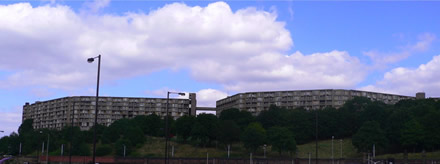
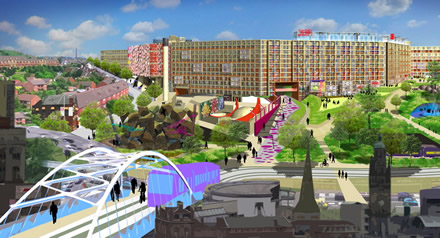
The £146m regeneration of Sheffield's Park Hill housing estate, which has this week been given the go-ahead, represents a remarkable reversal of fortunes for what had become a poster child/whipping-boy for the failures of modernism and mass housing. Snaking along a hillside in central Sheffield, Park Hill dominates the skyline, and casts a long shadow over Sheffield's fortunes.
Now, led by developers Urban Splash, the plan for the revitalised Park Hill is to bring some love in, and aims to soften the brutal modernism of the estate with a splash of colour, a dash of playfulness, and big dollops of gaudy landscaping.
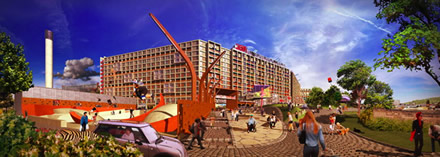
The brochures accompanying the Urban Splash proposal, featuring graphics by The Designers Republic, design concepts by Studio Egret West and archtectural plans by Hawkins Brown, are full of intriguing forms and bright colours, designed to give an impression of something rather than be too prescriptive at this early stage. It's nothing less than the Alsopification of Park Hill, where some gaudy daubs of colour and form stand in place of any real idea what's going to happen.
But of course the biggest change that will turn Park Hill into one of the most desirable locations in Sheffield will be that it will no longer be the domain of sink social housing for the dispossessed, the rootless and the shiftless, low-income families, teenage mothers and other benefit dependants. Such as monoculture was always a recipe for disaster.
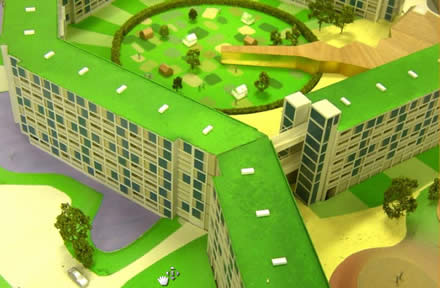
The regenerated Park Hill, like previous Urban Splash projects, will undoutedly see an influx of yuppies, trendies, middle income families, and the chattering, Guardian reading middle-classes. But, as the renaissance of the Barbican proves, and the recent renovation of the Brunswick Centre, people love a bit of brutalism, as long as they can get a cappuccino nearby. Brutalism doesn't really need to be 'softened up', all it needs is a Starbuck's and a Waitrose. It certainly doesn't need to dressed up with electric pink parasitic appendages or white metallic rose covered multi-storey car park facades. Actually, the facade proposals from Hawkins Brown,featuring bleached wooden decking and some pot plants in a kind of everytown Homebase-does-Scandi style are worse. Going too far down this route runs the risk of losing the essence, the frisson of the strange, Brutalism's dark promise, that makes Park Hill intriguing in the first place.
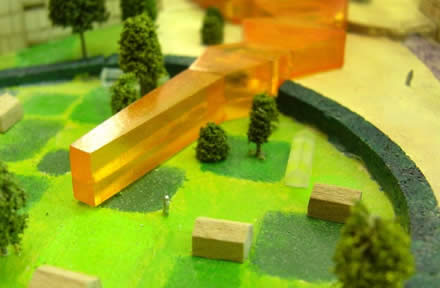
The brochures show how the new design aims to revitilise the housing stock of the estate, and turn the notorious "streets in the sky" into viable walkways and streetscapes rather than just a desolate network of muggers corners.
As the excellent post at Brand Avenue states, the designers of Park Hill, Ivor Smith and Jack Lynn, were strongly influenced by Alison and Peter Smithshon, who themselves were inspired by pop culture references, such as their competition entry for housing at Golden Lane.
With Urban Splash's proposal for the regeneration of Park Hill, things have turned full circle. The brochure and press material is littered with reference to Sheffield's pop illuminati, quoting ABC lyrics here, and namechecking the Human League and Pulp there. It's only surprising they haven't updated the brochures with the Arctic Monkeys.
Such attempts to piggyback on the pop-music archeology of Sheffield have in the past failed badly, as the operators of the National Museum of Popular Music discovered when it opened in 1999. Despite the mighty heritage of Human League, Joe Cocker and, err, Def Leppard, no-one came to visit the £14m building designed by Nigel Coates, and it closed 16 months later (and is no currently used as the Students Union by Sheffield Hallam University).
Impeccable pop credentials, music or architectural, won't save good intentions built in the wrong place.
